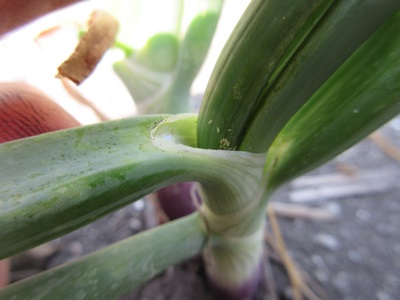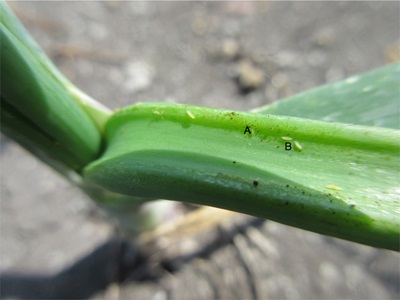Scouting for onion thrips
Learn how to identify onion thrips and cultural and biological control options.
Onion thrips (Thrips tabaci) feed on more than just onions; they also feed on cabbage, leaf lettuce, a variety of other vegetables and fruits, field crops, and many weed species. Thrips are unique from other insects as they have rasping-sucking mouthparts that allow them to scratch the cell walls of leaves, suck up the cell contents including the chlorophyll, and leave behind a shiny, translucent trail on the leaf. A single female can produce up to 80 eggs which hatch out in 5–10 days. Development from egg to adult takes 10–30 days and once mature, females start laying eggs. Under ideal conditions - hot and dry weather - populations of thrips can build up very quickly. With a relatively short life cycle, thrips have several overlapping generations through the summer months.
Onion thrips are approximately 1.5 mm in length, pale yellow and brown, and are very fast moving. They are able to reproduce asexually, and males are considered rare. Females have two pairs of slender fringed wings that extend slightly past the abdomen, and seven segments on each antenna. The pale-yellow larvae are about a quarter to half the size of the adults. The pre-pupa and pupa, both inactive/non-feeding stages, are usually present in the soil around the plants or at the base of the onion neck.
In Ontario, thrips generally overwinter in grain, clover, alfalfa, or hay fields. As these fields are cut or dry down, large populations move to neighbouring fields, generally in the first couple weeks of June. The first thrips of the season are commonly found around field borders. Thrips have been monitored in the past using white sticky traps which will allow for easy identification as they start to move into the field.
In onions, thrips tend to feed in the leaf axils on the newest leaf tissue. Detecting the first thrips of the season is possible by pulling apart the leaves and looking deep into the leaf axils. Since the first thrips survive deep within the leaf sheath, initially the leaf injury is hard to detect. Serious damage occurs when lesions become so numerous that the entire plant takes on a white or straw-coloured appearance. As the leaves grow, previous damage enlarges and adds to the characteristic streaking across the leaves. Feeding by thrips puts added stress on the onion and can make the onion more susceptible to bacterial and fungal pathogens. Severe feeding causes leaf distortion, wilting, browning, and premature lodging which all result in a reduction in yield of up to 50%.
Thrips should be scouted and counted before the decision is made to spray in the field. Inspect 25 plants and count the total number of thrips per plant and divide by the average number of leaves per plant to get the average number of thrips per leaf. The spray threshold is generally one adult per leaf or any sign of silvery feeding damage. To prevent the development of resistance, it is essential to always rotate between different insecticide groups with different modes of action. With thrips, past studies have shown that two applications of the same product applied 7-10 days apart targeting the same generation of thrips may be necessary for adequate control.
Currently there are many chemical products registered for thrips, all with varying levels of control. Agri-Mek SC(Group 6), Malathion 85E(1B), Dibrom(1B), and Movento 240 SC(23) have demonstrated good control. Movento 240 SC is systemic and has some residual activity that works better against larvae when it is applied earlier in the season. Using a penetrating surfactant can be useful to maximize the effectiveness of products against thrips.
Remember to remove volunteers of onions from past years or nearby fields as populations of thrips can build on these volunteers early in the season. A reduction in the amount of nitrogen applied at planting can reduce populations of onion thrips larvae early in the season as well as potentially reduce bacterial rot later in storage. Research has also shown that lack of adequate soil calcium may cause a higher population of thrips later in season.
With regards to cultural and biological control, onions with blue leaves and higher levels of wax have also shown to be more susceptible to thrips than cultivars with lower levels of wax and green leaves. Natural predators such as minute pirate bugs, lacewings, predatory mites, ladybird beetles, and spiders have shown to prey on onion thrips. Researchers are developing entomopathogenic fungi and testing mass rearing and releasing natural predators of onion thrips. These future biological controls may reduce the need for chemical insecticides if these methods are fine-tuned and economically feasible. Follow ONVegetables.com for more up to date information about onion thrips and other vegetable news.

